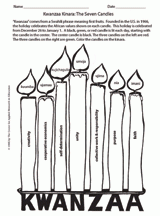Reference an article that outlines the symbols of Kwanzaa and celebrations for each day. This information is useful during the month of December, when Kwanzaa is celebrated.
Subjects:
Holidays:
This African American holiday season was developed in California in the 1960s so that African Americans could have their own special holiday at this time of year. "Kwanzaa" comes from the Swahili word meaning the first fruits of the harvest.
Excerpted from Let's Read.
These are the symbols of Kwanzaa and what they stand for:
- Kinara (kee-NAR-ah)--This is a candleholder for seven candles, standing for the family background. One candle is lit each evening. A black candle is in the middle to represent skin color, three red candles on one side represent struggles, and three green candles on the other side represent the future.
- Mkeka (m-KAY-kah)--This straw mat represents the foundation on which all else rests.
- Muhindi (muh-HIN-dee)--These ears of corn stand for the children of the family. One ear of corn for each is placed on the straw mat. Apples, nuts, and yams can also be added to remember the harvest from the earth.
- Matunda (ma-TOON-dah)--This is fruit placed in a basket to represent the bountiful harvest. Bread is sometimes added.
- Kikombe cha umoja (KI-kohm-bay cha oo-MO-jah)--This is a cup that represents "unity."
- Zawadi (za-wah-DEE)--These are the gifts that children receive for the hard work they have done during the year. (In Africa, children are not allowed to ask for gifts; they do not make a wish list, for example, but are grateful for what they receive.)
- First day. Greet classroom members. Be together. The greeting is "Habari gani" (hah-BAR-ee GAH-nee) which means that someone is asking "what is new?"
- Second day, "Kujichagulia" (koo-j ee-cha-goo-LEE-ah). Learn about family traditions and the traditions of your ancestors.
- Third day, "Ujima" (oo-JEE-mah). Time to do something together in your class; perhaps fix up or clean.
- Fourth day, "Ujamaa" (oo-jah-MAAH). Save coins all year and buy a gift that the whole class can share, not just one person.
- Fifth day, "Nia" (NEE-ah). What is your strength? What is your purpose in life?
- Sixth day, "Kuumba" (ku-OOM-bah). Devoted to creative endeavors. Make up a rhyme, a song, a poem, or paint a picture.
- Seventh day, "Imani" (ee-MAHN-ee). Express faith that good things will happen in the future. Then enjoy a meal together.
Excerpted from Let's Read.







